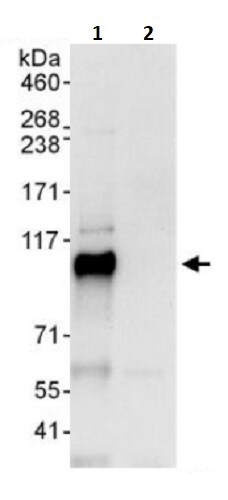Anti-NFXL1 antibody (ab242121)
Key features and details
- Rabbit polyclonal to NFXL1
- Suitable for: IP, WB
- Reacts with: Human
- Isotype: IgG
Overview
-
Product name
Anti-NFXL1 antibody
See all NFXL1 primary antibodies -
Description
Rabbit polyclonal to NFXL1 -
Host species
Rabbit -
Tested Applications & Species
See all applications and species dataApplication Species IP HumanWB Human -
Immunogen
Synthetic peptide within Human NFXL1 aa 600-650. The exact sequence is proprietary. NP_694540.3
Database link: Q6ZNB6 -
Positive control
- WB: HeLa, Jurkat and HEK-293T whole cell lysates. IP: HeLa whole cell lysate.
Properties
-
Form
Liquid -
Storage instructions
Shipped at 4°C. Store at +4°C short term (1-2 weeks). Upon delivery aliquot. Store at -20°C long term. Avoid freeze / thaw cycle. -
Storage buffer
pH: 6.8
Preservative: 0.09% Sodium azide
Constituents: Tris buffered saline, 0.1% BSA -
 Concentration information loading...
Concentration information loading... -
Purity
Immunogen affinity purified -
Purification notes
Antibody was affinity purified using an epitope specific to NFXL1 immobilized on solid support. -
Clonality
Polyclonal -
Isotype
IgG -
Research areas
Images
-
All lanes : Anti-NFXL1 antibody (ab242121) at 0.04 µg/ml
Lane 1 : HeLa (Human epithelial cell line from cervix adenocarcinoma) whole cell lysate at 50 µg
Lane 2 : HeLa (Human epithelial cell line from cervix adenocarcinoma) whole cell lysate at 15 µg
Lane 3 : Jurkat (Human T cell leukemia cell line from peripheral blood) whole cell lysate at 50 µg
Lane 4 : HEK-293T (Human epithelial cell line from embryonic kidney transformed with large T antigen) whole cell lysate at 50 µg
Developed using the ECL technique.
Predicted band size: 101 kDa
Exposure time: 3 minutes
-
NFXL1 was immunoprecipitated from HeLa (human epithelial cell line from cervix adenocarcinoma) whole cell lysate (1 mg per IP reaction; 20% of IP loaded).
ab242121 used for IP at 6 µg/mg lysate. For WB at 0.4 µg/ml.
Lane 1: ab242121 IP in HeLa whole cell lysate.
Lane 2: Control IgG IP in HeLa whole cell lysate.Chemiluminescence detection: 30 seconds.











